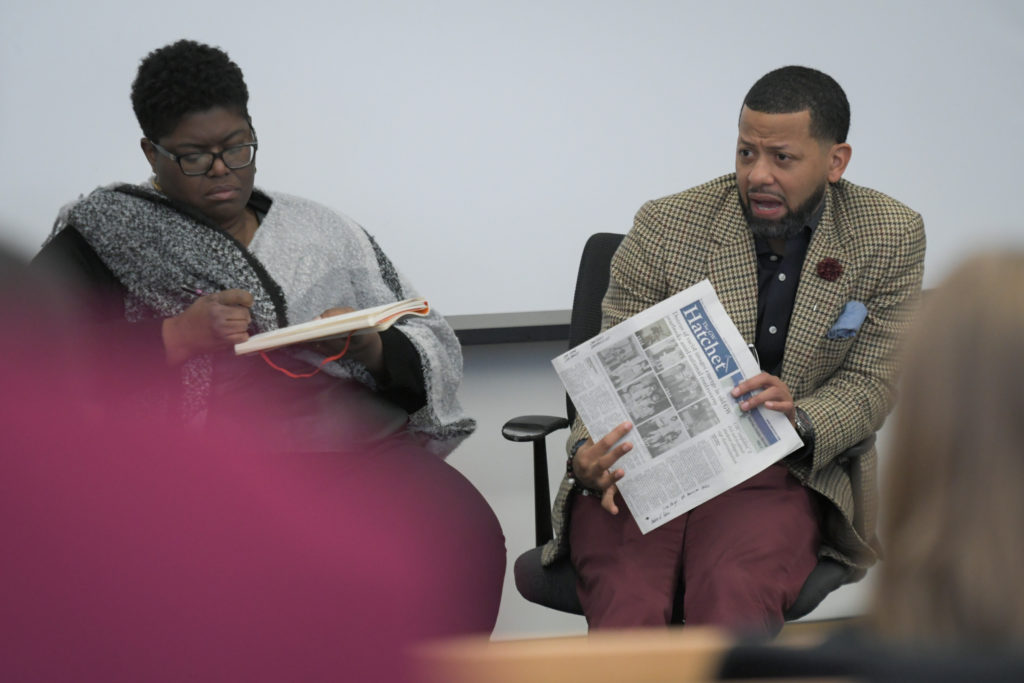Professors, students and staff discussed the history and legacy of blackface at a panel discussion Friday.
George Rice, the associate director of the Multicultural Student Services Center, joined three professors in the American and African studies departments to discuss the history and impact of minstrelsy – a common practice in the late 19th and early 20th centuries where white band members would blacken their faces and perform songs and music that originated in black communities.
Gayle Wald, the chair of the American studies department, said she organized the event in light of a Hatchet report revealing numerous racist photographs in old GW yearbooks and highly publicized controversies about blackface in Virginia.
Wald began the discussion by relaying the history of the minstrel show, which she called “a combination of music, dance, comedy, theater.” The shows, which originated in northern cities, were “the most popular form of mass entertainment in the United States” from the antebellum period through the 1900s, she said.
She said blackface minstrel shows were associated with the working class, leading to a belief that the shows were “disreputable theater” and “rowdy.” She said minstrelsy improved its reputation in the late 19th century among the upper classes.
[gwh_image id=”1080174″ credit=”Graeme Sloan | Contributing Photo Editor” align=”none” size=”embedded-img”]Gayle Wald, the chair of the American studies department and a professor of English and American studies, speaks at a panel on the history of blackface Friday.[/gwh_image]
Wald added that despite the racist origins of blackface minstrelsy and its bigoted depictions of black Americans, minstrelsy provided a platform for African American entertainers to become professionals and to mainstream black culture as early as the 1880s.
“Even though its impulses are traceable to a kind of grotesque disfiguration of black humanity, it also paradoxically provides an in for African American culture to make its imprint on, and kind of become, American popular culture,” Wald said.
Minstrelsy and its tradition of blackface “permeate our everyday lives, even if we’re not consciously engaged,” Wald said. She pointed to the popular ice cream truck jingle and the beat from the hip-hop single “Chain Hang Low,” both of which closely resemble the minstrel tune “Turkey in the Straw.”
Nicole Ivy, an assistant professor of American studies with a background in equity and inclusion in museums, said the existence of racist images and cultural appropriation in texts preserved for history, like art collections and yearbooks, merits a discussion about the ethics of maintaining those archived materials.
“I wonder what we might do with the materials produced, across these moments of mass culture production and consumption,” she said. “I’m interested in what it means to preserve these – what some folk might call objectionable materials. I’m interested in how we’re accountable for these materials.”
Ivy said that rather than destroying the materials, communities impacted by the images should examine the effects of racist people and images on the world today.
“The antidote for cultural appropriation is confrontation with racism,” she said. “The antidote for the way out of this seemingly interminable cultural appropriation debate might be to dig into a shared engagement with the legacies of racism and how they function institutionally.”
Rice, the associate director of the MSSC, said that although it can be tempting to think of diversity and inclusion as adequate solutions to past racism and cultural appropriation, people still need to provide underrepresented communities with equal opportunities.
“Way too often, we feel like if there’s diversity, then the problem’s solved, if there’s inclusion, then the problem’s solved,” he said. “I still feel like there’s a language of equity that has to be respected.”





